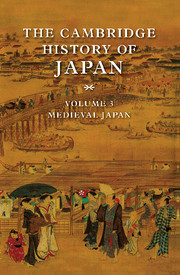Book contents
- Frontmatter
- Introduction
- 1 The Kamakura bakufu
- 2 Medieval shōen
- 3 The decline of the Kamakura bakufu
- 4 The Muromachi bakufu
- 5 Muromachi local government: shugo and kokujin
- 6 The decline of the shōen system
- 7 The medieval peasant
- 8 The growth of commerce in medieval Japan
- 9 Japan and East Asia
- 10 CULTURAL LIFE IN MEDIEVAL JAPAN
- 11 The other side of culture in medieval Japan
- 12 Buddhism in the Kamakura period
- 13 Zen and the gozan
- Works cited
- Glossary
- Index
- References
10 - CULTURAL LIFE IN MEDIEVAL JAPAN
Published online by Cambridge University Press: 28 March 2008
- Frontmatter
- Introduction
- 1 The Kamakura bakufu
- 2 Medieval shōen
- 3 The decline of the Kamakura bakufu
- 4 The Muromachi bakufu
- 5 Muromachi local government: shugo and kokujin
- 6 The decline of the shōen system
- 7 The medieval peasant
- 8 The growth of commerce in medieval Japan
- 9 Japan and East Asia
- 10 CULTURAL LIFE IN MEDIEVAL JAPAN
- 11 The other side of culture in medieval Japan
- 12 Buddhism in the Kamakura period
- 13 Zen and the gozan
- Works cited
- Glossary
- Index
- References
Summary
THE KAMAKURA PERIOD AND THE END OF BUDDHIST LAW
After senior retired emperor Toba died on the second day of the seventh month of 1156 (the first year of Hōgen), fighting and strife began in Japan, and the country entered the age of warriors.
This laconic statement came from the brush of the Buddhist priest Jien (1155–1225), the author of Gukanshō, an early-thirteenth-century history of Japan. Jien was a member of the ascendent northern branch of the Fujiwara and wrote Gukanshō in part to justify the historical success of his family as regent-rulers at the Heian court. But Jien is probably best remembered as the first historian in Japan to view the past in distinct terms of cause and effect and as a progression from one stage to another. Although earlier writers had not been totally oblivious to historical causality, none had sought to analyze Japanese history, as Jien did, within an overall, interpretive framework.
Jien's emphasis on the progress of history was not an aberrant view but, rather, emerged from a heightened awareness of the momentous historical changes that he himself witnessed. As observed in Gukanshō, Japan in the late 1100s was transformed from a comparatively peaceful and tranquil country under the rule of the imperial court to a tumultuous, strife-filled “age of warriors.” Yet the anguish that Jien and other members of the courtier elite experienced as a result of this transition was accepted fatalistically because of a belief in its inevitability: They were convinced that the period of mappō, or “the end of the Buddhist law,” had already begun a century before.
- Type
- Chapter
- Information
- The Cambridge History of Japan , pp. 447 - 499Publisher: Cambridge University PressPrint publication year: 1990

